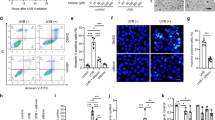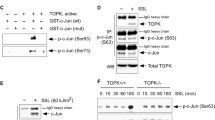Abstract
Skin cancer is the most common cancer in the United States, while DNA-damaging ultraviolet B (UVB) radiation from the sun remains the major environmental risk factor. Reducing skin cancer incidence is becoming an urgent issue. The energy-sensing enzyme 5′-AMP-activated protein kinase (AMPK) has a key role in the regulation of cellular lipid and protein metabolism in response to stimuli such as exercise and changes in fuel availability. However, the role of AMPK in the response of skin cells to UVB damage and in skin cancer prevention remains unknown. Here we show that AMPK activation is reduced in human and mouse squamous cell carcinoma as compared with normal skin, and by UVB irradiation, suggesting that AMPK is a tumor suppressor. At the molecular level, AMPK deletion reduced the expression of the DNA repair protein xeroderma pigmentosum C (XPC) and UVB-induced DNA repair. AMPK activation by its activators AICAR (5-aminoimidazole-4-carboxamide ribonucleoside) and metformin (N′,N′-dimethylbiguanide), the most widely used antidiabetic drug, increased the expression of XPC and UVB-induced DNA repair in mouse skin, normal human epidermal keratinocytes, and AMPK wild-type (WT) cells but not in AMPK-deficient cells, indicating an AMPK-dependent mechanism. Topical treatment with AICAR and metformin not only delayed onset of UVB-induced skin tumorigenesis but also reduced tumor multiplicity. Furthermore, AMPK deletion increased extracellular signal-regulated kinase (ERK) activation and cell proliferation, whereas AICAR and metformin inhibited ERK activation and cell proliferation in keratinocytes, mouse skin, AMPK WT and AMPK-deficient cells, suggesting an AMPK-independent mechanism. Finally, in UVB-damaged tumor-bearing mice, both topical and systemic metformin prevented the formation of new tumors and suppressed growth of established tumors. Our findings not only suggest that AMPK is a tumor suppressor in the skin by promoting DNA repair and controlling cell proliferation, but also demonstrate previously unknown mechanisms by which the AMPK activators prevent UVB-induced skin tumorigenesis.
This is a preview of subscription content, access via your institution
Access options
Subscribe to this journal
Receive 50 print issues and online access
$259.00 per year
only $5.18 per issue
Buy this article
- Purchase on Springer Link
- Instant access to full article PDF
Prices may be subject to local taxes which are calculated during checkout






Similar content being viewed by others
Abbreviations
- 6-4PP:
-
pyrimidine(6-4)pyrimidone dimers
- ACC:
-
acetyl-CoA carboxylase
- AICAR:
-
AI, 5-aminoimidazole-4-carboxamide ribonucleoside
- AMPK:
-
5′-AMP-activated protein kinase
- CPD:
-
cyclobutane pyrimidine dimers
- EGFR:
-
epidermal growth factor receptor
- ERK:
-
extracellular signal-regulated kinase
- KO:
-
knockout
- Met:
-
metformin
- mTOR:
-
mammalian target of rapamycin
- mTORC1:
-
mTOR complex 1
- NHEK:
-
normal human epidermal keratinocytes
- UVB:
-
Ultraviolet B
- Veh:
-
vehicle
- WT:
-
wild type
- XPC:
-
xeroderma pigmentosum group C
References
Bode AM, Dong Z . Mitogen-activated protein kinase activation in UV-induced signal transduction. Sci STKE 2003; 2003: RE2.
Bowden GT . Prevention of non-melanoma skin cancer by targeting ultraviolet-B-light signalling. Nat Rev Cancer 2004; 4: 23–35.
Johnson TM, Dolan OM, Hamilton TA, Lu MC, Swanson NA, Lowe L . Clinical and histologic trends of melanoma. J Am Acad Dermatol 1998; 38: 681–686.
Niggli HJ, Rothlisberger R . Cyclobutane-type pyrimidine photodimer formation and induction of ornithine decarboxylase in human skin fibroblasts after UV irradiation. J Invest Dermatol 1988; 91: 579–584.
Vink AA, Berg RJ, de Gruijl FR, Roza L, Baan RA . Induction, repair and accumulation of thymine dimers in the skin of UV-B-irradiated hairless mice. Carcinogenesis 1991; 12: 861–864.
Garinis GA, Mitchell JR, Moorhouse MJ, Hanada K, de Waard H, Vandeputte D et al. Transcriptome analysis reveals cyclobutane pyrimidine dimers as a major source of UV-induced DNA breaks. EMBO J 2005; 24: 3952–3962.
Ries G, Heller W, Puchta H, Sandermann H, Seidlitz HK, Hohn B . Elevated UV-B radiation reduces genome stability in plants. Nature 2000; 406: 98–101.
Kraemer KH . Sunlight and skin cancer: another link revealed. Proc Natl Acad Sci USA 1997; 94: 11–14.
Jans J, Schul W, Sert YG, Rijksen Y, Rebel H, Eker AP et al. Powerful skin cancer protection by a CPD-photolyase transgene. Curr Biol 2005; 15: 105–115.
You YH, Lee DH, Yoon JH, Nakajima S, Yasui A, Pfeifer GP . Cyclobutane pyrimidine dimers are responsible for the vast majority of mutations induced by UVB irradiation in mammalian cells. J Biol Chem 2001; 276: 44688–44694.
Kraemer KH, Lee MM, Scotto J . DNA repair protects against cutaneous and internal neoplasia: evidence from xeroderma pigmentosum. Carcinogenesis 1984; 5: 511–514.
Kraemer KH, Lee MM, Andrews AD, Lambert WC . The role of sunlight and DNA repair in melanoma and nonmelanoma skin cancer. The xeroderma pigmentosum paradigm. Arch Dermatol 1994; 130: 1018–1021.
He YY, Pi J, Huang JL, Diwan BA, Waalkes MP, Chignell CF . Chronic UVA irradiation of human HaCaT keratinocytes induces malignant transformation associated with acquired apoptotic resistance. Oncogene 2006; 25: 3680–3688.
Wischermann K, Popp S, Moshir S, Scharfetter-Kochanek K, Wlaschek M, de Gruijl F et al. UVA radiation causes DNA strand breaks, chromosomal aberrations and tumorigenic transformation in HaCaT skin keratinocytes. Oncogene 2008; 27: 4269–4280.
Sugasawa K, Ng JM, Masutani C, Iwai S, van der Spek PJ, Eker AP et al. Xeroderma pigmentosum group C protein complex is the initiator of global genome nucleotide excision repair. Mol Cell 1998; 2: 223–232.
Sugasawa K . UV-induced ubiquitylation of XPC complex, the UV-DDB-ubiquitin ligase complex, and DNA repair. J Mol Histol 2006; 37: 189–202.
Cleaver JE . Cancer in xeroderma pigmentosum and related disorders of DNA repair. Nat Rev Cancer 2005; 5: 564–573.
Cleaver JE, Lam ET, Revet I . Disorders of nucleotide excision repair: the genetic and molecular basis of heterogeneity. Nat Rev Genet 2009; 10: 756–768.
Mihaylova MM, Shaw RJ . The AMPK signalling pathway coordinates cell growth, autophagy and metabolism. Nat Cell Biol 2011; 13: 1016–1023.
Luo Z, Saha AK, Xiang X, NB Ruderman . AMPK, the metabolic syndrome and cancer. Trends Pharmacol Sci 2005; 26: 69–76.
Luo Z, Zang M, Guo W . AMPK as a metabolic tumor suppressor: control of metabolism and cell growth. Future Oncol 2010; 6: 457–470.
Jones RG, Plas DR, Kubek S, Buzzai M, Mu J, Xu Y et al. AMP-activated protein kinase induces a p53-dependent metabolic checkpoint. Mol Cell 2005; 18: 283–293.
Drakos E, Atsaves V, Li J, Leventaki V, Andreeff M, Medeiros LJ et al. Stabilization and activation of p53 downregulates mTOR signaling through AMPK in mantle cell lymphoma. Leukemia 2009; 23: 784–790.
Fu X, Wan S, Lyu YL, Liu LF, Qi H . Etoposide induces ATM-dependent mitochondrial biogenesis through AMPK activation. PLoS One 2008; 3: e2009.
Nathan DM, Buse JB, Davidson MB, Ferrannini E, Holman RR, Sherwin R et al. Medical management of hyperglycemia in type 2 diabetes: a consensus algorithm for the initiation and adjustment of therapy: a consensus statement of the American Diabetes Association and the European Association for the Study of Diabetes. Diabetes Care 2009; 32: 193–203.
Foretz M, Hebrard S, Leclerc J, Zarrinpashneh E, Soty M, Mithieux G et al. Metformin inhibits hepatic gluconeogenesis in mice independently of the LKB1/AMPK pathway via a decrease in hepatic energy state. J Clin Invest 2010; 120: 2355–2369.
Miller RA, Birnbaum MJ . An energetic tale of AMPK-independent effects of metformin. J Clin Invest 2010; 120: 2267–2270.
Pollak M . Metformin and other biguanides in oncology: advancing the research agenda. Cancer Prev Res (Phila) 2010; 3: 1060–1065.
Ben Sahra I, Le Marchand-Brustel Y, Tanti JF, Bost F . Metformin in cancer therapy: a new perspective for an old antidiabetic drug? Mol Cancer Ther 2010; 9: 1092–1099.
Guo D, Hildebrandt IJ, Prins RM, Soto H, Mazzotta MM, Dang J et al. The AMPK agonist AICAR inhibits the growth of EGFRvIII-expressing glioblastomas by inhibiting lipogenesis. Proc Natl Acad Sci USA 2009; 106: 12932–12937.
Woodard J, Platanias LC . AMP-activated kinase (AMPK)-generated signals in malignant melanoma cell growth and survival. Biochem Biophys Res Commun 2010; 398: 135–139.
Saha AK, Persons K, Safer JD, Luo Z, Holick MF, Ruderman NB . AMPK regulation of the growth of cultured human keratinocytes. Biochem Biophys Res Commun 2006; 349: 519–524.
Ming M, Shea CR, Guo X, Li X, Soltani K, Han W et al. Regulation of global genome nucleotide excision repair by SIRT1 through xeroderma pigmentosum C. Proc Natl Acad Sci USA 2010; 107: 22623–22628.
Ming M, Feng L, Shea CR, Soltani K, Zhao B, Han W et al. PTEN positively regulates UVB-induced DNA damage repair. Cancer Res 2011; 71: 5287–5295.
Zhang J, Bowden GT . UVB irradiation regulates Cox-2 mRNA stability through AMPK and HuR in human keratinocytes. Mol Carcinog 2008; 47: 974–983.
Kim J, Yoon MY, Choi SL, Kang I, Kim SS, Kim YS et al. Effects of stimulation of AMP-activated protein kinase on insulin-like growth factor 1- and epidermal growth factor-dependent extracellular signal-regulated kinase pathway. J Biol Chem 2001; 276: 19102–19110.
Du J, Guan T, Zhang H, Xia Y, Liu F, Zhang Y . Inhibitory crosstalk between ERK and AMPK in the growth and proliferation of cardiac fibroblasts. Biochem Biophys Res Commun 2008; 368: 402–407.
Wang J, Whiteman MW, Lian H, Wang G, Singh A, Huang D et al. A non-canonical MEK/ERK signaling pathway regulates autophagy via regulating Beclin 1. J Biol Chem 2009; 284: 21412–21424.
Shackelford DB, Shaw RJ . The LKB1-AMPK pathway: metabolism and growth control in tumour suppression. Nat Rev Cancer 2009; 9: 563–575.
Green AS, Chapuis N, Maciel TT, Willems L, Lambert M, Arnoult C et al. The LKB1/AMPK signaling pathway has tumor suppressor activity in acute myeloid leukemia through the repression of mTOR-dependent oncogenic mRNA translation. Blood 2010; 116: 4262–4273.
Ben Sahra I, Regazzetti C, Robert G, Laurent K, Le Marchand-Brustel Y, Auberger P et al. Metformin, independent of AMPK, induces mTOR inhibition and cell-cycle arrest through REDD1. Cancer Res 2011; 71: 4366–4372.
Laderoute KR, Amin K, Calaoagan JM, Knapp M, Le T, Orduna J et al. 5'-AMP-activated protein kinase (AMPK) is induced by low-oxygen and glucose deprivation conditions found in solid-tumor microenvironments. Mol Cell Biol 2006; 26: 5336–5347.
Ming M, Han W, Maddox J, Soltani K, Shea CR, Freeman DM et al. UVB-induced ERK/AKT-dependent PTEN suppression promotes survival of epidermal keratinocytes. Oncogene 2010; 29: 492–502.
Han W, Ming M, He YY . Caffeine promotes UVB-induced apoptosis in human keratinocytes without complete DNA repair. J Biol Chem 2011; 286: 22825–22832.
Maeda T, Chua PP, Chong MT, Sim AB, Nikaido O, Tron VA . Nucleotide excision repair genes are upregulated by low-dose artificial ultraviolet B: evidence of a photoprotective SOS response? J Invest Dermatol 2001; 117: 1490–1497.
Acknowledgements
This work was supported by NIH grant ES016936 (YYH), the University of Chicago Comprehensive Cancer Center Pilot program (P30 CA014599), the CTSA (NIH UL1RR024999) and UC Friends of Dermatology Research Funds. We thank Terri Li for the Ki67 immunohistochemistry, Dr Pradip Raychaudhuri (University of Illinois at Chicago, Chicago, IL, USA) for kindly providing the XPC promoter luciferase construct, and Dr Ann Motten for critical reading of the manuscript.
Author information
Authors and Affiliations
Corresponding author
Ethics declarations
Competing interests
The authors declare no conflict of interest.
Additional information
Supplementary Information accompanies the paper on the Oncogene website
Supplementary information
Rights and permissions
About this article
Cite this article
Wu, C., Qiang, L., Han, W. et al. Role of AMPK in UVB-induced DNA damage repair and growth control. Oncogene 32, 2682–2689 (2013). https://doi.org/10.1038/onc.2012.279
Received:
Accepted:
Published:
Issue Date:
DOI: https://doi.org/10.1038/onc.2012.279
Keywords
This article is cited by
-
AMPK, a key molecule regulating aging-related myocardial ischemia-reperfusion injury
Molecular Biology Reports (2024)
-
Oral intake of bucillamine, carvedilol, metformin, or phenformin does not protect against UVR-induced squamous cell carcinomas in hairless mice
Photochemical & Photobiological Sciences (2024)
-
Metformin reduces the cellular DNA repair capacity and enhances the effect of curcumin on the induction of apoptosis in AGS gastric cancer cells
Egyptian Journal of Medical Human Genetics (2023)
-
Spatiotemporal roles of AMPK in PARP-1- and autophagy-dependent retinal pigment epithelial cell death caused by UVA
Journal of Biomedical Science (2023)
-
Modulation of autophagy, apoptosis and oxidative stress: a clue for repurposing metformin in photoaging
Inflammopharmacology (2022)



